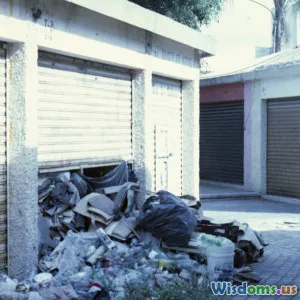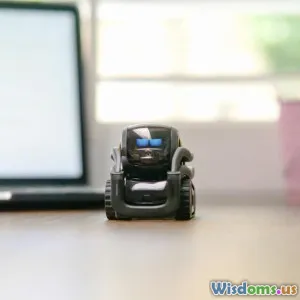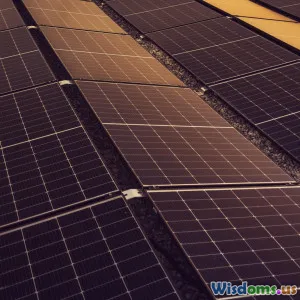
The Challenges of Cleaning Up Space Junk in Earth’s Orbit
9 min read Exploring the complex challenges and innovative solutions to combat the growing problem of space junk orbiting Earth. (0 Reviews)
The Challenges of Cleaning Up Space Junk in Earth’s Orbit
Introduction
Imagine thousands of ships navigating a narrow canal, some drifting dangerously without control—now scale that image to 35,000 kilometers above Earth, cluttered not with seafaring vessels but with tons of defunct satellites, rocket parts, and tiny fragments. This is the stark reality of space junk, a growing hazard threatening our increasingly satellite-dependent civilization. As the space frontier grows busier with satellites launching daily for communication, navigation, and Earth observation, the problem of space debris—commonly called space junk—has evolved from an inconvenience to a potentially catastrophic risk. Cleaning up this orbital clutter is far from simple; it involves scientific, technical, political, and economic hurdles.
This comprehensive article delves into the complexities of addressing space junk in Earth’s orbit, offering insights into the scale of the problem, the risks involved, and the innovative but challenging solutions scientists and engineers are pursuing.
Understanding the Problem: What Is Space Junk?
Space junk consists of defunct human-made objects in orbit around the Earth, including inactive satellites, spent rocket stages, fragmentation debris from collisions or explosions, and even tiny paint flecks. To put this into perspective:
- The United States Space Surveillance Network tracks over 27,000 pieces of orbital debris larger than a softball.
- Estimates suggest there are millions of smaller debris fragments ranging from 1 mm to 10 cm.
- These small fragments travel at speeds exceeding 28,000 km/h, making even tiny objects capable of damaging functioning spacecraft.
According to data from NASA and the European Space Agency (ESA), Low Earth Orbit (LEO) between 200 and 2,000 km altitude contains the densest concentration of debris. This region is crucial as it hosts most imaging satellites and the International Space Station (ISS).
The Risks of Orbital Debris
Collision Cascades and the Kessler Syndrome
The primary concern with space debris is the potential for collisions which can generate even more debris in a cascading effect known as the Kessler Syndrome. Proposed by NASA scientist Donald J. Kessler in 1978, this concept describes a scenario where collisions create debris fields, heightening the risk of further collisions and potentially rendering certain orbits unusable.
Real-world manifestations include:
- The 2009 collision between the active Iridium 33 satellite and the defunct Russian Cosmos-2251 satellite, which produced more than 2,000 trackable debris pieces.
- Anti-satellite missile tests, like those conducted by China in 2007, which created thousands of dangerous debris fragments.
These incidents highlight how a single event can drastically increase the debris population.
Threat to Active Space Operations
Space agencies spend considerable resources tracking debris to avoid collisions with critical assets such as the ISS and communication satellites. A collision with even a small piece of debris can damage sensitive equipment, disable satellites, and jeopardize human lives onboard crewed missions. The cost of replacing damaged satellites and lost data runs into billions annually.
Challenges in Cleaning Up Space Junk
Technical Complexities
-
Tracking Small Debris: Objects smaller than 10 cm are difficult to track because they are beyond the limits of most radar and optical tracking systems. Yet, these small particles can incapacitate spacecraft due to their tremendous velocity.
-
Diverse Orbital Speeds and Trajectories: Debris travel in hundreds of orbital paths and speeds, making targeting individual pieces akin to catching speeding bullets in three-dimensional space.
-
Lack of Designed Retrieval Features: Most debris is leftover hardware not equipped with systems for easy capture or deorbit, requiring creative solutions.
Economic and Political Hurdles
-
Funding Limitations: Cleanup missions require considerable investment, but the benefits, often global, don’t neatly align with individual entities’ interests.
-
Liability and Ownership: Debris remains the property of the original launchers under international law. Permission is needed to remove or interact with objects owned by others, creating complex legal negotiations.
-
International Coordination: Space is a shared domain needing multinational cooperation for effective mitigation and cleanup efforts.
Innovative Solutions and Technologies
Researchers and companies worldwide are exploring novel methods to tackle space debris proactively.
Passive Mitigation Strategies
These involve reducing future debris generation:
- Designing Satellites for Demise: Satellites manufactured to burn up entirely on re-entry.
- End-of-Life Maneuvers: Satellites are programmed to deorbit or move to ‘graveyard’ orbits.
Active Debris Removal (ADR) Technologies
-
Harpoons and Nets: Missions like ESA’s planned e.Deorbit propose capturing defunct satellites with nets or harpoons—leveraging straightforward physical capture, though still amidst technical validation.
-
Robotic Arms: Japan’s JAXA has explored the use of robotic arms on spacecraft to grab and remove debris.
-
Electrodynamic Tethers: A passive method using electromagnetic forces to alter the orbit and speed up atmospheric re-entry.
-
Laser Ablation: Ground- or space-based lasers gently nudge debris orbits, causing them to re-enter Earth's atmosphere sooner.
Two notable demonstration projects include:
- ClearSpace-1: Slated for launch in the mid-2020s by ESA, this mission aims to actively capture and deorbit a piece of debris using robotic arms.
- RemoveDEBRIS: A UK-based project that successfully tested net and harpoon capture technologies on the International Space Station.
Conclusion
The burgeoning cloud of space debris orbiting Earth presents a daunting challenge—a perfect storm of high speed, high risk, difficult logistics, and complex international politics. However, the urgency to address space junk has galvanized a global response, promoting innovative technical solutions and encouraging new international policies focused on sustainable space use.
Long-term space sustainability will demand persistent investment in debris removal technologies, international cooperation, and designing future space missions with debris mitigation in mind. Protecting Earth’s orbital environment is not only essential for current space operations but also crucial to ensure the safe and fruitful expansion of humanity’s reach beyond our home planet.
As we stand on the frontier of space commercialization and exploration, cleaning up our orbital neighborhood becomes more than a scientific pursuit—it is an imperative for the stewardship of space as a shared resource for all humankind.
Author’s note: Readers curious about the current status of orbital debris tracking and space environmental policies can follow updates from NASA’s Orbital Debris Program Office and ESA’s Space Debris Office.
Rate the Post
User Reviews
Popular Posts




















